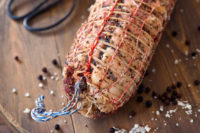Foodservice operators are offering convenience, portability and flavor — all before the clock strikes 11 a.m.
Anytime the Oak Brook, Ill.-based giant makes changes to its menus, it’s news; but many foodservice operators today are more focused on value and discounts than cutting-edge product development, says Darren Tristano, executive vice president of Technomic, the Chicago-based foodservice research and consulting firm. And their breakfast protein of choice continues to be pork, in the form of such staples as bacon and sausage, rather than chicken or beef. However, restaurants that offer convenience, portability and quick service will always remain competitive.
The main reason consumers stop at a fast-food or full-service restaurant on their way to work, after all, is for taste, variety, a welcoming environment, good coffee, friendly employees and healthy options, says Tristano, citing Technomic data from the fourth quarter of 2007.
“The challenge is to get consumers to eat in restaurants — fast-food chains really only have five chances a week,” he says. “So they have to provide something that consumers can’t make at home.”
According to Wade Thoma, vice president of menu management for McDonald’s
“Industry and consumer trends indicate chicken consumption is on the rise, and McDonald’s is now giving its customers a chance to enjoy it for breakfast,” says Thoma. “Additionally, the new Southern Style Chicken Biscuit and
McDonald’s sweet tea and iced coffees also represent regional menu items that are gaining acceptance and popularity throughout its
“Customers want a homemade breakfast experience,” notes Thoma. “They want to taste fresh ingredients like eggs, sausage and biscuits, and they expect the same quality of food they can get at home. McDonald’s offers a great deal of variety for breakfast, and our customers react well to that.”
Fill 'er up — with protein
Given its
In contrast, Carl’s Jr. stores in the Southwest tend to sell a higher percentage of breakfast burritos, such as the Steak & Egg Burrito, Loaded Breakfast Burrito and Bacon & Egg Burrito, served with fresh homemade salsa. This month, Carl’s Jr. is launching a new monster breakfast sandwich — made of two eggs, ham, bacon, sausage and cheese — following the success of its portable Breakfast Burger of charbroiled all-beef patty, fried egg, bacon, hash brown nuggets, American cheese and ketchup on a sesame seed bun.
“We’re always looking for something new to offer so consumers will be tempted to stop by more often — particularly items that build interest because they are around for a limited time only. In recent years we’ve had success with breakfast sweet goods, as well,” says
He notes that many people’s breakfasts become a habitual meal occasion, much more so than their lunches or dinners. Indeed, many people could eat the same breakfast every day, whereas few want to eat the same dinner even twice a week.
Many foodservice operators are experimenting with adding healthier options to their breakfast menus, but for now, Hardee’s and Carl’s Jr. are going to stick with what they do best: provide fresh, hearty breakfasts in convenient formats. For example, breakfast eaters shouldn’t expect to find smoothies on those chains' menu, while they still remain a fad instead of a trend, says
“There’s a place for healthy items, but in the near future they won’t outsell other options,” says
Adding value to the menu
For a limited time, its new Cheesy Bacon BK Wrapper will be available for a suggested retail price of $1.39. The new breakfast wrap features eggs, bacon, hash browns, American cheese and a smoky cheese sauce rolled up in a soft flour tortilla. It will also be available as a Breakfast Value Meal, as two wraps, a small serving of hash browns and a small coffee.
“The Cheesy Bacon BK Wrapper hits so many consumer priorities: it’s portable, full of flavor and texture — the hash browns provide a surprise crunch — and offered at a reasonable price point,” says John Schaufelberger, senior vice president, global product marketing and innovation for Burger King. “It’s been a huge success and operators have been very pleased as well.”
Schaufelberger notes that protein obviously plays an important role at Burger King. The Croissan’Wich is the King’s flagship breakfast sandwich, and consumers can order it in a variety of proteins (sausage, bacon and ham), with egg and/or American cheese combinations.
“There’s not a lot of ingredients that you can play with at breakfast, but great chefs innovate,” says Schaufelberger. “That’s been critical to the success of our Croissan’Wich and limited-time-only offerings.”
Recently, Burger King began offering a Mocha BK JOE Iced Coffee all day for $1, attempting to offer a less expensive alternative to the $4-plus versions found at chain coffee shops across the country. In July, Burger King will also launch Fresh Apple Fries — fresh apples cut in the shape of French fries with a low-fat dipping sauce — for breakfast, lunch and dinner.
Last summer, Burger King launched Cheesy Tots, bite-sized fried hash browns with cheese, which are now available all day.
Cutting fat and calories, preserving taste
According to Mary Cusick, senior vice president of marketing for Bob Evans Farms Inc., “many consumers want healthier, lighter options and smaller portions,” she says. “They are more interested and aware of the different kinds of protein today, so they will often buy lower-fat turkey sausage, for example, in addition to sausage today.”
With the Breakfast Bites option, for example, breakfast eaters could enjoy a traditional meal but with smaller portions for smaller appetites. A classic breakfast of sausage links and griddle pancakes, for example, would be served with only two links and two pancakes. Cusick notes that baby boomers and empty nesters particularly find it important to customize their own meal.
The Fit From the Farm breakfasts also provide healthier, smaller customized options, such as mini fruit-and-yogurt parfaits with turkey sausage. The Fit From the Farm Breakfast Combo, made for one, comes with Bob Evans Egg Lites, one turkey sausage link and a choice of one fruit-and-yogurt crepe, a mini fruit-and-yogurt parfait or a cup of oatmeal.
“Consumers want something that tastes good, and healthy foods have a reputation as being less flavorful,” says Cusick. “We want to provide a balance of great flavor and value. Being flexible with our menu choices helps customers substitute fruit for potatoes, for example.”
Consumers definitely think of quality sausage as being an important part of breakfast at Bob Evans, and that’s not going to change.
“Breakfast is our heritage,” says Cusick, noting that Bob Evans began as a 24/7 breakfast restaurant.
What are consumers ordering?
Bacon 36 percent
Sausage patties 31 percent
Ham 10 percent
Canadian bacon 8 percent
No meat 5 percent
Steak 3 percent
Analyzing the breakfast crowd
Protein-enhanced or protein breakfast items can certainly meet those requirements. St. Louis-based Solae's recent survey of 1,000 consumers who reportedly ate breakfast at least three times a week also revealed that there are six distinct segments of breakfast eaters:
• On-the-run eaters (20 percent), who often eat breakfast in the car, on the way to work or when they arrive at work.
• Snackers (18 percent), who routinely choose morning snacks to hold them over until lunch.
• Guilt avoiders (17 percent), who make healthier choices for breakfast so as to accommodate later-day indulgences.
• Mood- and productivity-concerned decision makers (15 percent), who feel strongly that productivity or mood is impacted when energy levels fade.
• Nutrition seekers (15 percent), who routinely strive to make healthy breakfast choices as part of an overall wellness-centered lifestyle.
• Energy/Jump-start seekers (15 percent), who seek foods and beverages that will wake them up and get them going in the morning.
The surveyed breakfast eaters also expressed a widespread understanding and appreciation for the benefits of protein in the morning.
“When asked on an unaided basis to list the benefits of consuming protein, the study found that consumers equate protein with energy and stamina, muscle and body growth, and hunger management and satiety benefits. Those answers are consistent with past research on protein awareness,” says Jean Heggie, director of marketing for Solae.



Report Abusive Comment